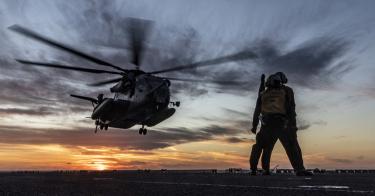Speaking in October this year on the readiness of U.S. armed forces, then-Secretary of Defense Mark Esper referenced Task Force Smith—a unit decimated in the early days of the Korean War as a result of being sent into combat with insufficient training, inadequate munitions and equipment, and understrength manning.
This spectacular battlefield failure gave birth to a new rallying cry: “No more Task Force Smiths!”
As the military ramps up for great power competition, the lessons of Task Force Smith still resonate within the Pentagon. After two decades of focusing on terrorists and other non-state opponents, the U.S. Joint Force must once again consider battle with major state powers. None of the services wants to find itself as unready for that kind of fight as was Task Force Smith. Yet each faces challenges.
The Navy, for example, is still recovering from years of being under-resourced in manning and high operational tempo. This has produced inadequate training and maintenance backlogs—problems that directly contributed to two fateful collisions in 2017 and the deaths of 17 sailors. Yet even as the Navy strives to address these shortcomings, some are calling to cut defense spending by as much as 10 percent.
History cautions against such moves. The Navy has its own version of Task Force Smith: the Battle of Java Sea, which saw the total destruction of an allied naval force hurriedly cobbled together in the chaos following the Japanese attack on Pearl Harbor.
In the Highest Degree Tragic, Donald M. Kehn’s book about that debacle, provides timely lessons. Using previously unavailable first-person accounts and declassified records, Kehn identifies the conditions leading to failure at the Battle of Java Sea—conditions that were set years before World War II began.
Despite years of service in China and the Philippines, the crews of the U.S. Navy’s Asiatic Fleet had little familiarity with the region beyond their routine operating areas. Dutch and British prewar sensitivity to provoking the Japanese had made U.S. ships unwelcome in the Dutch East Indies and British Malaya.
When war arrived, these ships found themselves operating from unfamiliar ports in little known waters. And those shortcomings might have been mitigated if given sufficient time and the full support of alliance partners.
Sadly, however, friction at the highest levels of the combined force and between the governments only exacerbated these difficulties in the early weeks of the war. They remained unresolved at the time the Japanese juggernaut reached British Malaya and the Dutch East Indies.
By late 1941, Japanese imperial forces were rampaging through the South and Southwest Pacific, seizing ports, airfields and critical industrial sites across the Philippines, the Solomon Islands, New Guinea, the Dutch East Indies, the Malay Peninsula and elsewhere. In response, the governments of the United States, Great Britain, the Netherlands and Australia began negotiations to establish a combined military command to resist the Japanese.
At the Arcadia Conference on Dec. 29, it was decided that a combined allied force was needed. Overall command would be given to British Gen. Archibald Wavell, and naval command to U.S. Adm. Thomas C. Hart. On Jan. 1, 1942, the American, British, Dutch and Australian (ABDA) combined command formally came into being.
As ABDA negotiations progressed in London, events in Asia were quickening. Gen. Douglas MacArthur declared Manila an open city, and U.S. naval forces began moving south to support a new allied effort: the defense of the so-called Malaya Barrier. On Jan. 15, 1942, ABDA deployed limited forces to defend Singapore and strategic oil fields of the Dutch East Indies.
Operating with only what they had at hand after departing the Philippines, crews made do. Using antiquated weapons, they fought courageously with unfamiliar partners, in outclassed ships, under inadequate air cover, while always outnumbered.
The British preoccupation with defending Singapore and the Dutch focus on defending their colony resulted in already meager ABDA naval forces being thinly divided. This confounded any attempt to mass sufficient naval power to counter moves made by Japan. Not surprisingly, the Japanese Imperial Navy and Army were able to rapidly advance, using occupied airfields to extend their land-based air cover throughout the East Indies.
After the fall of Singapore on Feb. 15 and Bali by the 20th, ABDA’s main naval component—the Striking Force—was bottled up in the Java Sea. Reinforcements from Australia or British India were cut off. Escape was impossible.
Throughout the campaign, air reconnaissance had been spotty, failing to detect Japanese invasion forces until late in the game, and even then able to provide only limited insight as to their composition and strength. On the evening of Feb. 26, this situation proved fatal when the Striking Force sortied to intercept anticipated Japanese invasion forces.
Meanwhile, a vain attempt was being made to reinforce air defenses on Java Island via the last remaining accessible allied port. Departing from Darwin, Australia, the USS Langley was transporting crated P-40 fighters to the Javanese port of Tjilatjap. Lacking adequate air cover and with the Japanese Imperial Navy patrolling the waters, the Langley’s survival hinged on stealth in the darkness of night.
Communication snafus ensued, delaying the ship and thereby mortally exposing it to daylight observation and attack from Japanese aircraft the next day.
As the so-called Malaya Barrier collapsed, surviving naval forces found it increasingly difficult to access limited supplies—including critical 5-inch anti-aircraft ammunition and torpedoes. A problem compounded by the fact that a batch of faulty 5-inch shells were not discovered in the Asiatic Fleet’s inventory due to prewar cost savings preventing live ammunition exercising that would have uncovered the problem sooner—perhaps in time to have prepositioned working ammunition in Tjilatjap.
Making matters worse, the lack of prewar tactical exercises by Asiatic Fleet destroyer squadrons had resulted in the excessive expenditure of torpedoes early in the war. The unnecessarily high release of ordnance is not uncommon among crews new to combat. It frequently confounds peacetime headquarters’ plans for munitions stockpiling and distribution. However, prewar cost savings tended to shortcut at-sea training that would have slowed the rate at which these critical and deadly effective weapons would have been expended, perhaps even saving a few Allied ships.
ABDA’s Striking Force made its final sortie on the evening of Feb. 27. The flagship light cruiser HNLMS De Ruyter was sunk by the modern and well-trained Imperial Japanese Navy. Japanese forces then set about destroying the rest of the now-disorganized force. Within days ABDA collapsed, leaving Japan with mastery of the Asia-Pacific from Sumatra eastward to the Solomon Islands and north to the Korean Peninsula.
As today’s U.S. Navy ponders how it might return to these waters in a future war against China, the lessons of Java Sea are especially relevant. Access to ports, the distribution of supplies and maintenance facilities, familiarity with the region, and effective working relationships with partners will all bear on the success of combat operations against the People’s Liberation Army Navy.
Like the Asiatic Fleet before it, the U.S. Navy is developing concepts expected to guide how forces will fight, but these concepts have yet to be exercised or resourced with the necessary ships and munitions.
The Marine Corps’ Expeditionary Advanced Base Operations concept assumes a degree of adequate logistic support and access to host nations to deploy sea-denial capabilities still in development. Meanwhile, the Navy’s Distributed Maritime Operations concept assumes many smaller warships can confound Chinese targeting and overwhelm their defenses, but today’s fleet has yet to build ships in the numbers needed.
Both approaches, and the Army’s Multi-Domain Operations concept backed by long-range fires, rely on familiarity of the battlefield and the peoples with which they will be teamed. Because of this, it is critical for U.S. forces to routinely operate with its allies where fighting is most likely to occur.
Gaining familiarity with distant ports and the waters of the first island chain can convert this challenge to a home-side advantage. As ABDA learned the hard way in Tjilatjap, prepositioning munitions and fuel in multiple locations is critical to sustaining operations under the constant threat of aerial attack—much as U.S. forces would today from Chinese ballistic and cruise missile attacks.
Task Force Smith was judged by readiness metrics of its day as ready for combat, but battlefield performance proved otherwise despite the heroism of the soldiers.
The Asiatic Fleet did what it could with truncated prewar budgets for training, stockpiling of munitions, and antiquated weapon systems—but came up short.
Meeting readiness metrics set in peacetime for ship maintenance, munitions, communications and training will likely be just as inadequate today as they were in 1942 and 1950. That is, unless it accounts for operating where the fighting will occur while demonstrating proficiency in the concepts of war required.
Readiness for war will only really be known once a force engages in combat, which makes it all the more important to ensure readiness standards and objectives reflect as realistically as possible the actual conditions one might expect in war against a named opponent.
Task Force Smith found itself wholly inadequate to the task, a consequence of poor training, equipment, manning and thinking. A decade earlier, the ABDA Command force met a similarly disastrous fate for many of the same reasons.
At this time, the Navy confronts an energetic and rapidly growing modern Chinese navy. Cutting resources is ill advised given the vital need for training at sea, practicing with allies, modernizing weapons and better maintaining ships.
Congress and military leaders should pay careful attention to the lessons of these past events so as to avoid the same fate. For the Navy and the country it serves, everything hangs in the balance.
This piece originally appeared in National Defense




